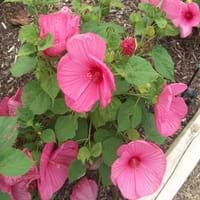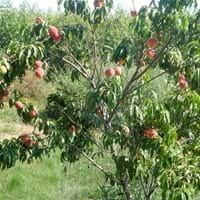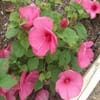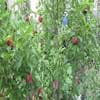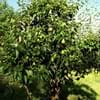Life Span
Annual and Perennial
Perennial
Type
Broadleaf Evergreen
Fruit
Origin
Not Available
China
Types
Hibiscus Luna Pink Swirl
Hibiscus Luna Red
Hibiscus Luna White
Tuscany, Royal Gem, Flavortop, Crimson Baby, Fantasia
Habitat
gardens, Grassland, Homesteads, Subtropical climates, tropical environments
Warmer regions
USDA Hardiness Zone
9-15
5-9
AHS Heat Zone
Not Available
9-1
Sunset Zone
21,22
H1, 1a, 1b, 2a, 2b, 3a, 3b, 6, 7, 8, 9, 10, 11, 12, 13, 14, 15, 16, 18, 19, 20, 21, 22, 23, 24
Habit
Oval or Rounded
Oval or Rounded
Flower Color
Light Pink, Pink, White
White, Red, Light Pink, Rose
Flower Color Modifier
Bicolor
Bicolor
Fruit Color
Non Fruiting Plant, Peach, White, Yellow
White, Yellow, Red, Pink, Peach
Leaf Color in Spring
Dark Green
Green
Leaf Color in Summer
Dark Green
Green
Leaf Color in Fall
Dark Green
Green
Leaf Color in Winter
Dark Green
Light Green
Leaf Shape
Ovate
Long, simple, curved and folded
Plant Season
Spring, Summer, Fall, Winter
Spring
Sunlight
Full Sun, Partial Sun
Full Sun
Growth Rate
Medium
Medium
Type of Soil
Loam
Loam, Sand
The pH of Soil
Neutral
Acidic, Neutral
Soil Drainage
Well drained
Well drained
Bloom Time
Early Summer, Summer, Late Summer, Early Fall, Fall, Indeterminate
Spring
Tolerances
Drought, Variety of soil types
Drought
Where to Plant?
Ground, Pot
Ground
How to Plant?
Stem Cutting, Tip cutting, Vegetative Reproduction
Budding, Grafting, Seedlings
Plant Maintenance
Medium
Medium
Watering Requirements
It cannot sustain wet-feet, Keep the Soil well drained, Requires watering in the growing season, Water Deeply, Water frequently while growing, Water more in summer, Water when soil is dry
Average Water Needs, Requires regular watering
In Summer
Lots of watering
Lots of watering
In Spring
Moderate
Moderate
In Winter
Average Water
Average Water
Soil pH
Neutral
Acidic, Neutral
Soil Type
Loam
Loam, Sand
Soil Drainage Capacity
Well drained
Well drained
Sun Exposure
Full Sun, Partial Sun
Full Sun
Pruning
A hard prune may be necessary if the plant becomes woody, Cut leaves after fall, Cut or pinch the stems, Pinch or prune as they grow to promote branching and bushiness, Prune for shortening long shoots, Prune in early summer, Remove deadheads
Remove damaged leaves, Remove dead branches, Remove dead leaves
Fertilizers
Apply 10-10-10 amount, Balanced liquid fertilizer, Do not fertilize new plants until at least a month, Use a low phosphate fertilizer to improve the quality of the blooms
All-Purpose Liquid Fertilizer
Pests and Diseases
Aphids, Mealybugs, Red spider mite, Scale, Thripes, Whiteflies
Red blotch
Plant Tolerance
Drought, Variety of soil types
Drought
Flower Petal Number
Single
Single
Fragrant Flower
No
Insignificant
Foliage Texture
Medium
Medium
Foliage Sheen
Glossy
Glossy
Attracts
Bees, Butterflies, Hummingbirds
Bees, Hummingbirds, Insects
Allergy
no allergic reactions
Anaphylaxis, Asthma, Bronchial-constrictions, Food Allergy, Urticaria
Aesthetic Uses
Beautification, Borders, Landscape Designing
Beautification
Beauty Benefits
Hair Conditioner, Not Available, Prevents greying of hair, Prevents Premature Baldness, Promotes Healthy Hair, Promotes healthy skin, Speed hair growth
Good for skin, Making cosmetics
Environmental Uses
Air purification
Air purification
Medicinal Uses
anti-inflammatory, Diuretic, Hair Loss, High blood pressure, Vitamin C
Aphrodisiac, Blood stasis and neurodegenerative diseases, Cancer, cholesterol-lowering, Combats Stress, Culinary Usage, Diuretic, Hair Loss, Hypokalemia, Obesity, Skin Disorders, Stomach pain, Weight loss
Part of Plant Used
Flowers, Leaf Stalks, Leaves
Bark, Flowers, Leaves, Seeds
Other Uses
Culinary use, Employed in herbal medicine, Jam, Jelly, Making Shampoo, Oil is used for aromatherapy, Oil is used in perfume, soaps, creams, etc., Showy Purposes, Traditional medicine, Use in Chinese herbology, Used As Food, Used as Ornamental plant, Used for bedding in gardens, Used for fragrance, Used for its medicinal properties, Used in making beverages, Used in paper industry, Used in salads, Used to make hair tonic
For making oil, Gum, Used as a dye, Used as Ornamental plant
Used As Indoor Plant
No
No
Used As Outdoor Plant
Yes
Yes
Garden Design
Container, Foundation, Houseplant, Mixed Border, Tropical
Container, Fruit / Fruit Tree, Topiary / Bonsai / Espalier
Botanical Name
Hibiscus moscheutos
PRUNUS persica nectarine
Common Name
Luna Rose, Common Rose Mallow, Common Swamp Mallow
Nectarine, Hardy Red
In Hindi
हिबिस्कुस लूना गुलाब
आड़ू
In German
Hibiscus Luna Rose
Dwarf Nectarine
In French
Hibiscus Luna Rose
Dwarf Nectarine
In Spanish
Hibiscus Luna Rose
Dwarf Nectarine
In Greek
Hibiscus Luna Rose
Dwarf Nectarine
In Portuguese
Hibiscus Luna Rose
Dwarf Nectarine
In Polish
Hibiscus Luna Rose
Dwarf Nectarine
In Latin
Hibiscus rosa Luna
Hardy Red
Phylum
Magnoliophyta
Magnoliophyta
Class
Magnoliopsida
Magnoliopsida
Family
Malvaceae
Rosaceae
Clade
Angiosperms, Eudicots, Rosids
Angiosperms, Eudicots, Rosids
Tribe
Hibisceae
Not Available
Subfamily
Malvoideae
Not Available
Number of Species
Not Available
Season and Care of Hibiscus Luna Rose and Dwarf Nectarine
Season and care of Hibiscus Luna Rose and Dwarf Nectarine is important to know. While considering everything about Hibiscus Luna Rose and Dwarf Nectarine Care, growing season is an essential factor. Hibiscus Luna Rose season is Spring, Summer, Fall and Winter and Dwarf Nectarine season is Spring, Summer, Fall and Winter. The type of soil for Hibiscus Luna Rose is Loam and for Dwarf Nectarine is Loam, Sand while the PH of soil for Hibiscus Luna Rose is Neutral and for Dwarf Nectarine is Acidic, Neutral.
Hibiscus Luna Rose and Dwarf Nectarine Physical Information
Hibiscus Luna Rose and Dwarf Nectarine physical information is very important for comparison. Hibiscus Luna Rose height is 600.00 cm and width 60.00 cm whereas Dwarf Nectarine height is 150.00 cm and width 150.00 cm. The color specification of Hibiscus Luna Rose and Dwarf Nectarine are as follows:
Hibiscus Luna Rose flower color: Light Pink, Pink and White
Hibiscus Luna Rose leaf color: Dark Green
Dwarf Nectarine flower color: White, Red, Light Pink and Rose
- Dwarf Nectarine leaf color: Green
Care of Hibiscus Luna Rose and Dwarf Nectarine
Care of Hibiscus Luna Rose and Dwarf Nectarine include pruning, fertilizers, watering etc. Hibiscus Luna Rose pruning is done A hard prune may be necessary if the plant becomes woody, Cut leaves after fall, Cut or pinch the stems, Pinch or prune as they grow to promote branching and bushiness, Prune for shortening long shoots, Prune in early summer and Remove deadheads and Dwarf Nectarine pruning is done Remove damaged leaves, Remove dead branches and Remove dead leaves. In summer Hibiscus Luna Rose needs Lots of watering and in winter, it needs Average Water. Whereas, in summer Dwarf Nectarine needs Lots of watering and in winter, it needs Average Water.
